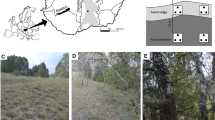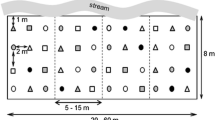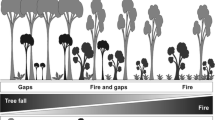Abstract
The Chilean matorral is characterized by multispecific shrub clumps in dry areas but has a continuous canopy in wetter sites. It has been hypothesized that this difference is due to easier recolonization of open patches by shrub seedlings under more mesic conditions. Within the mesic range of the matorral we designed a field experiment to compare shrub seedling emergence, growth, and survival under the closed canopy of a secondary forest versus three types of open patches: burned, cleared of shrubs but with a herbaceous layer present, and clear without a herbaceous layer. After the first summer, survival of Quillaja saponaria seedlings was 75% in the burned site, 30% in the cleared patch without herbaceous vegetation, and 15% with herbaceous vegetation present, whereas there was 0% survival under the secondary forest canopy. After eight years, the percentages had dropped to: 22%, 12% and 3%, respectively. These results contrast strongly with the seedling establishment patterns in drier areas of the matorral where early seedling survival is higher under the shade of large shrubs. In the experimental mesic sites, seedlings did best on the burned site, not only in terms of survival, but also in terms of growth. After one year, seedling mean height was 10.2 cm in the burned site, whereas 3.8 cm and 5.3 cm in the cleared patches without and with herbaceous respectively. After eight years, mean height differences between treatments had increased further: 147.7 cm in the burned site, 40.3 cm in the cleared patch without herbaceous cover and 13 cm in the cleared patch with herbs. Our results indicate that the facilitative effect of nurse shrubs on seedling establishment found in dry ranges of the matorral is less important in more mesic sites. This difference may explain the continuous shrub cover in relatively mesic areas as opposed to the characteristic patchy structure of the matorral in its drier range.
Similar content being viewed by others
References
Abrams, M. D. 1988. Sources of variation in osmotic potential with special reference to North American tree species. For. Sci. 34: 1030–1046.
Armesto, J. J. & Pickett, S. T. 1985. A mechanistic approach to the study of succession in the Chilean matorral. Revista Chilena de Historia Natural 58: 9–17.
Armesto, J. J., Vidiella, P. E. & Jiménez, H. E. 1995. Evaluating causes and mechanisms of succession in the mediterranean regions in Chile and California. Pp. 418–434. In: Arroyo, M. T. K., Zedler, P. H. & Fox, M. D. (eds), Ecology and biogeography of mediterranean ecosystems in Chile, California, and Australia. Ecological Studies, Vol. 108. Springer-Verlag, New York, Inc., USA.
Augé, R. M., Stodola, J. W. & Gealy, D. M. 1990. Turgor maintenance in Rosa rugosa at three levels of nitrogen and subjected to drought. J. Environ. Hort. 8: 108–112.
Avila, G., Montenegro, G. & Aljaro, M. E. 1988. Incendios en la vegetación mediterránea. Pp. 80–87. In: Fuentes, E.R. & Prenafeta, S. (eds), Ecología del paisaje en Chile central. Pontificia Universidad Católica de Chile, Santiago, Chile.
Bauer, H. L. 1943. The statistical analysis of chaparral and other plant communities by means of transect samples. Ecology 24: 45–60.
Bertness, M. D. & Callaway, R. M. 1994. Positive interactions in communities. Trends Ecol. Evol. 9: 191–193.
Christensen, N. L & Muller, C. H. 1975. Effects of fire on factors controlling plant growth in Adenostoma chaparral. Ecol. Monog. 45: 29-55.
CONAF. 1995. Estadísticas de ocurrencia y daño de incendios forestales, temporadas 1964-1995. Informe Estadístico # 44. Corporación Nacional Forestal, Chile.
Fuentes, E. R. & Hajek, E. R. 1989. Patterns of landscape modification in relation to agricultural practice in central Chile. Environ. Cons. 6: 265–271.
Fuentes, E. R., Jaksić, F.M. & Simonetti, J. 1983. European rabbits vs. native mammals: effects on shrub seedlings. Oecologia (Berlin) 58: 411–414.
Fuentes, E. R., Segura, A. M. & Avilés, R. 1989. Landscape change under indirect effects of human use: the savanna of central Chile. Landscape Ecol. 2: 73–80.
Fuentes, E. R., Segura, A. M. & Holmgren, M. 1994. Are the responses of matorral shrubs different from those in an ecosystem with a reputed fire history? Pp.16–25. In: Moreno, J. M. & Oechel, W. C. (eds), The role of fire in mediterranean-type ecosystems. Springer-Verlag, New York.
Fuentes, E. R., Hoffmann, A. J., Poiani, A. & Alliende, M. C. 1986. Vegetation change in large clearings: patterns in the Chilean matorral. Oecologia (Berlin) 68: 358–366.
Fuentes, E. R, Otaiza, R. D., Alliende, M. C., Hoffmann, A. J. & Poiani, A. 1984. Shrub clumps of the Chilean matorral vegetation: structure and possible maintenance mechanisms. Oecologia (Berlin) 62: 405–411.
Giliberto, J. & Estay, H. 1978. Seasonal water stress in some Chilean matorral shrubs. Bot. Gaz. 139: 236–240.
Gutiérrez, J. R. & Armesto, J. 1981. El rol del ganado en la dispersión de semillas de Acacia caven. Ciencia e Investigación Agraria 8: 3–8.
Holmgren, M., Scheffer, M. & Huston, M. A. 1997. The interplay of facilitation and competition in plant communities. Ecology 78: 1966–1975.
Jaksić, F. M., Schlatter, R. P. & Yañez, J. L. 1980. Feeding ecology of central Chilean foxes, Dusicyon culpaeus and Dusicyon grisaceus. J. Mammal. 61: 254–260.
Jiménez, H. E. & Armesto, J. J. 1992. Importance of the soil seed bank of disturbed sites in Chilean matorral in early secondary succession. J. Veg. Sci. 3: 579–586.
Keeley, S. C. & Johnson, A. W. 1977. A comparison of the pattern of herb and shrub growth in comparable sites in Chile and California. Am. Midland Nat. 97: 120–132.
Kleiner, K. W., Abrams, M. D. & Schultz, J. C. 1992. The impact of water and nutrient deficiencies on the growth, gas exchange and water relations of red oak and chestnut oak. Tree Physiol. 11: 271–287.
Lahiri, A. N. 1980. Interaction of water stress and mineral nutrition on growth and yield. Pp. 341–352. In: Turner, N. C. & Kramer, P. J. (eds), Adaptation of plants to water and high temperatures stress. John Wiley and Sons, New York, USA.
Lawrence, G. E. 1966. Ecology of vertebrate animals in relation to chaparral fire in the Sierra Nevada foothills. Ecology 47: 278–291.
Lazo, I. & Fuentes, E. R. 1994. Human disturbance and colonization of Trevoa trinervis (Rhamnaceae) in the matorral of central Chile. VII Conference on mediterranean-type ecosystems. Noticiero de la Sociedad de Biología de Chile 2: 35.
Martínez, J. A. & Armesto, J. J. 1983. Ecophysiological plasticity and habitat distribution in three evergreen species of the Chilean matorral. Oecologia Plantarum 4: 211–219.
McNaughton, S. J. 1991. Dryland herbaceous perennials. Pp. 307–328. In: Mooney, H. A., Winner, W. E. & Pell, E. J. (eds), Response of plants to multiple stresses. Academic Press, New York, USA.
Mills, J. N. 1986. Herbivores and early postfire succession in southern California chaparral. Ecology 67: 1637–1649.
Moreno, J. M. & Oechel, W. C. 1992. Factors controlling post-fire seedling establishment in southern California chaparral. Oecologia 90: 50–60.
Muñoz, M. & Fuentes, E. R. 1990. Does fire induce shrub germination in the Chilean matorral? Oikos 56: 177–181.
Radin, J. W. & Ackerson, R. C. 1981. Water relations of cotton plants under nitrogen deficiency. III. Stomatal conductance, photosynthesis and abscisic acid accumulation during drought. Plant Physiol. 67: 115–119.
Radin, J. W. & Parker, L. L. 1979. Water relations of cotton plants under nitrogen deficiency. I. Dependence upon leaf structure. Plant Physiol. 64: 495–498.
Rovira, A. 1984. Geografía de los suelos. Colección Geografía de Chile. Tomo V. Ediciones Instituto Geográfico Militar. Santiago, Chile.
Schulze, E. D. 1991.Water and nutrient interactions with plant water stress. Pp. 89–101. In: Mooney, H. A., Winner, W. E. & Pell, E. J. (eds), Response of plants to multiple stresses. Academic Press, New York, USA.
Segura, A. M., Holmgren, M., Anabalón, J. J. & Fuentes, E. R. 1998. The significance of fine intensity in creating local patchiness in the Chilean matorral. Plant Ecology 139: 259–264.
Snedecor, G. W. & Cochran, W. G. 1980. Statistical Methods. The Iowa State University Press, USA.
Stock, W. D. & Lewis, O. A. M. 1986. Soil nitrogen and the role of fire as a mineralizing agent in a South African coastal fynbos ecosystem. J. Ecol. 74: 317–328.
Thomas, C. M. & Davis, S. D. 1989. Recovery patterns of three chaparral shrub species after wildfire. Oecologia 80: 309–320.
Thrower, N. & Bradbury, D. 1977. Chile-California mediterranean scrub atlas. Dowden, Hutchinson and Ross, Stroudsbourg PA, USA.
Tyler, C. M. 1996. Relative importance of factors contributing to postfire seedling establishment in maritime chaparral. Ecology 77: 2182–2195.
Tyler, C. M. & D'Antonio, C. M. 1995. The effects of neighbors on the growth and survival of shrub seedlings following fire. Oecologia 102: 255–264.
Viro, P. J. 1974. Effects of forest fire on soil. Pp. 7–45. In: Kozlowski, T. T. & Ahlgren, C. E. (eds), Fire and ecosystems. Academic Press, New York, USA.
Vogl, R. J. 1969. One hundred and thirty years of plant succession in a southwestern Wisconsin lowland. Ecology 53: 1179–1188.
Wellington, A. B. 1984. Leaf water potentials, fire and the regeneration of mallee eucalyptus in semi-arid, south-eastern Australia. Oecologia 64: 360–362.
Author information
Authors and Affiliations
Rights and permissions
About this article
Cite this article
Holmgren, M., Segura, A.M. & Fuentes, E.R. Limiting mechanisms in the regeneration of the Chilean matorral – Experiments on seedling establishment in burned and cleared mesic sites. Plant Ecology 147, 49–57 (2000). https://doi.org/10.1023/A:1009804726307
Issue Date:
DOI: https://doi.org/10.1023/A:1009804726307




